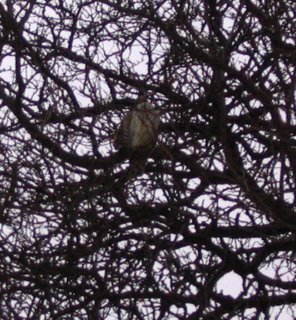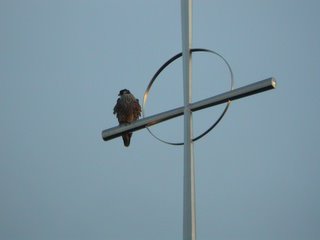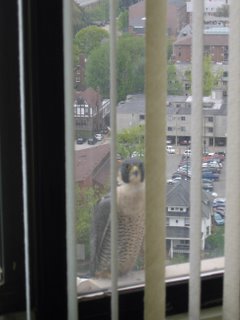Real Audio : MP3 download
Post Script: The following is from an e-mail received from Diana Grunloh, who works on the UIUC campus, the day after this story ran.
It is rare indeed for me to have what I call a "Marty Stauffer Moment" and then have it confirmed on radio. This happened last evening as I was leaving work at the Illini Union. While walking down the Quad I saw what appeared to be a falcon fly into an oak tree there. I really did not believe my eyes, so I moved closer to see...YES a Peregrine Falcon sitting on a low branch preening his feathers. I snapped many "not really close enough" pictures (see below right) to compare with my Audubon Guide at home. And then, an even more amazing thing...on my drive home what should come on AM 580 but Environmental Almanac and you, sir, talking about the very falcon I had just seen.

If you think of wildlife as something that exists “out there,” away from buildings and streets and the bustle of human activity, I’d like to call your attention to a bird that might prompt you to reconsider.
It’s a peregrine falcon, for my money, one of the coolest birds in the world. This is the bird that reaches speeds of up to two hundred miles an hour in its spectacular hunting dives.
And let me clarify here, I don’t just want to introduce you to peregrines by telling you some interesting things about them as a species, although I am going to do that. I want to introduce you to an individual peregrine that many listeners should be able to see without going far out of their way.
 Back in late November, birders in and around Champaign-Urbana began spotting a peregrine, mostly as it hunted pigeons near the U of I South Farms. (I first saw it there on Thanksgiving Day with my brother, who introduced me to birding twenty years ago, and who was visiting from New Hampshire. Thanks, John.) More recently, birders who work on the U of I campus have noticed a peregrine, presumably the same one, which shows up pretty regularly at a highly visible, central campus location.
Back in late November, birders in and around Champaign-Urbana began spotting a peregrine, mostly as it hunted pigeons near the U of I South Farms. (I first saw it there on Thanksgiving Day with my brother, who introduced me to birding twenty years ago, and who was visiting from New Hampshire. Thanks, John.) More recently, birders who work on the U of I campus have noticed a peregrine, presumably the same one, which shows up pretty regularly at a highly visible, central campus location.If you’d like to look for the peregrine yourself, here’s what you need to know: late in the afternoon, he often perches on the cross atop the spire of the Wesley United Methodist Church, at the southeast corner of Green and Mathews. (Photo above by Greg Lambeth, birdman extraordinaire, taken February 5, 2006.) He usually arrives sometime between 4:15 and 5:00 o’clock, and stays for anywhere from a few minutes to a half hour or more.
The bird you’re looking for is perhaps sixteen inches long from bill to tail tip, and the spire he perches on stands a hundred eighty four feet tall. When he’s up there, you can tell from blocks away. But to see any detail on our peregrine you will need to be much closer, and to use binoculars.
In good light you should be able to make out the dark, helmet-like markings on his head, and the wide lines that extend down over his cheek like exaggerated sideburns. People with better eyes than mine are able to see a green leg band, which indicates this peregrine comes from a breeding program.
As you may or may not remember, peregrines were extirpated from most of their range in the United States by the pesticide DDT, before it was banned in 1972. They were protected under the Endangered Species Act until 1999, when, thanks to extensive breeding and reintroduction programs, their numbers had recovered to sustainable levels.
The peregrine’s robust recovery depended on its tolerance for life among people, a trait not shared by some other endangered birds. Prior to urbanization, most North American peregrines nested on cliffs. But they now also thrive in habitat created by humans, nesting on the ledges of tall buildings and bridges, even in densely populated cities.
Of course there’s no guarantee that the U of I peregrine will show up at his late afternoon perch on any given day—and I’m a little anxious that he’ll never be seen again, now that I’ve talked about him on the radio. But he has been observed fairly regularly since December, and I urge you to keep an eye out for this magnificent bird.
 Note: After this story was recorded for radio I learned of another peregrine (or peregrines) spotted in Spring 2005 and again this winter at the Presidential Tower, 302 East John Street in Champaign. The photo right was taken last April by Jackie Roy, who works in the State 4-H office, looking south from the 19th floor. The bird in the photo is an adult, so it's not the same as this year's spire bird, which is a juvenile.
Note: After this story was recorded for radio I learned of another peregrine (or peregrines) spotted in Spring 2005 and again this winter at the Presidential Tower, 302 East John Street in Champaign. The photo right was taken last April by Jackie Roy, who works in the State 4-H office, looking south from the 19th floor. The bird in the photo is an adult, so it's not the same as this year's spire bird, which is a juvenile.



